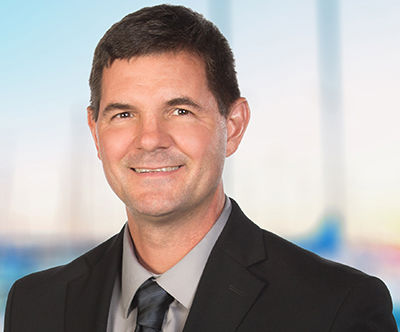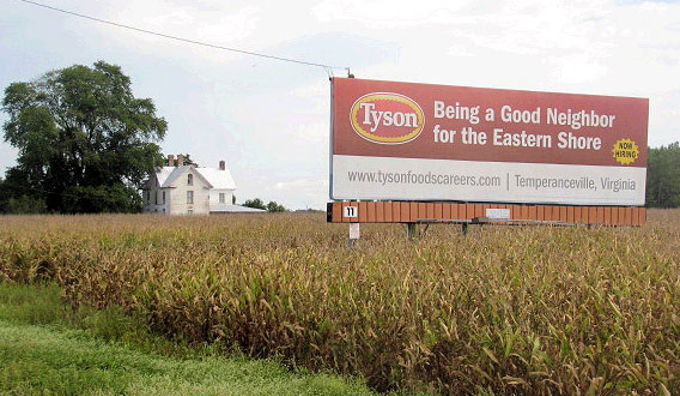
Large Poultry Farming Operations Harm the VA Eastern Shore Environment
Poultry Farms Harm Virginia's Eastern Shore
The Eastern Shore of Virginia is a uniquely beautiful area. Located on the Delmarva Peninsula and separated from the rest of the Commonwealth by the Chesapeake Bay, it has a history and a culture all its own. The southern portion of the peninsula is home to Northampton County, an area that is known primarily for seafood and tourism. Accomack County, to the north, hosts some of the largest poultry farming operations in the world.
The massive amount of waste (principally manure) generated by these large poultry farming operations builds up as these poultry farms spread across Accomack County, with associated environmental harm. These large poultry farming operations also extract enormous quantities of groundwater from the aquifers that serve as the sole source of freshwater for the Virginia Eastern Shore. How, and to what extent, the poultry industry should be regulated is becoming a major source of controversy in this otherwise quiet locale.
The Rise of Industrial Farming (A Brief History)
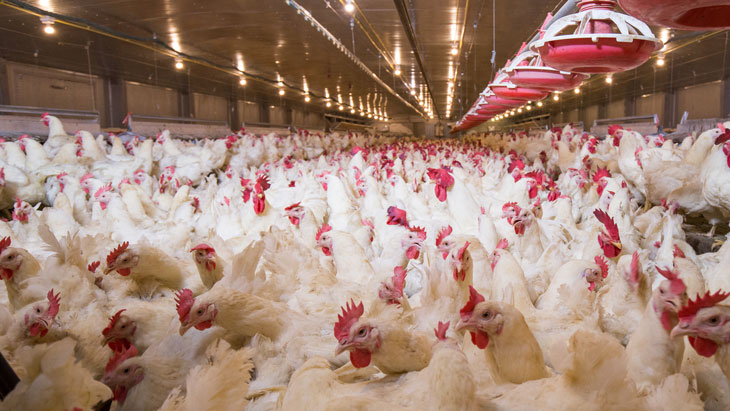
Chayakorn Lotongkum/Shutterstock.com
Farming has always been a vital part of the American experience, but the role of the farmer has changed substantially in the last hundred years. Up through the 1920s most of the food eaten by Americans came from small, family-owned farms. This began to change in the 1930s with the advent of industrial farming operations. Full-scale industrial farming began with the pork industry. In fact, Henry Ford even credited the “disassembly line” method used in these highly mechanized swine slaughterhouses for giving him the idea for his famous automobile assembly line.[1]
From the 1930s onward, large-scale farming operations spread from the pork industry to nearly every type of livestock. Their numbers began to increase dramatically, and continue to increase without any signs of slowing. For example, the United States Department of Agriculture (USDA) estimates that from 1982 to 2002, the number of large farms across the nation grew from 3,600 to almost 12,000, an increase of 234 percent. [2] As the population – and appetite – of the United States continues to grow, so do the numbers of these giant farms.
Larger Operations Leads to More Waste
The rise of new technologies and the ever-increasing size of these operations have driven the traditional family farmer nearly to extinction. Rather than running small self-contained operations, today more and more farmers contract with large companies who operate an industrial food enterprise on the farmer’s land.
Most poultry farmers today have contracts with “vertically-integrated” meat packing companies, such as Tyson and Purdue, through which the meat packing companies provide housing and facilities to raise the animals from infancy to the time they go to the slaughterhouse.[3] These companies own the animals and control all phases of production, including what and when the animals are fed.
However, despite the fact that these large “vertically-integrated” meat packing companies control nearly all aspects of the meat and egg production, it is the poultry farmers, and not the large “vertically-integrated” company, that remains responsible for animal waste management under the contracts.
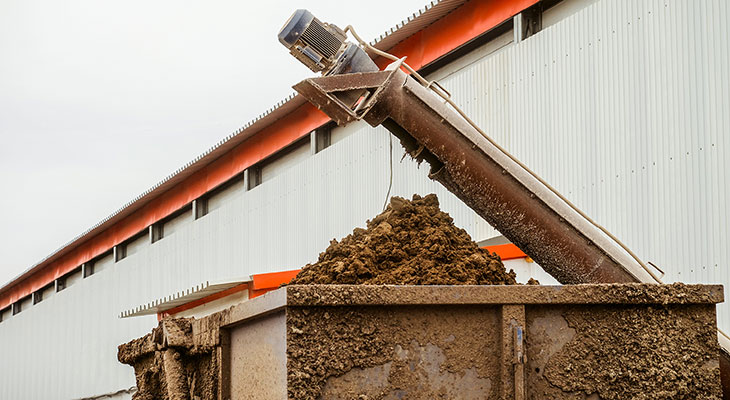
Chicken Waste Being Removed From Chicken Housing Facility on Industrial Poultry Farm
N-Sky/Shutterstock.com
The amount of waste produced by these operations is enormous. “A 20,000-bird broiler house will produce approximately 150 tons of litter per year ”,[4] with litter being a mixture of poultry excreta (manure), spilled feed, feathers and material used as bedding in poultry operations. A flock of 14,000 breeder hens will produce approximately 150 tons of manure . . . per year”.[5]
There are, of course, multiple 20,000 bird broiler houses at the large industrial poultry farming operations in Accomack County. Unlike human sanitary waste, which is required by the Clean Water Act to be treated before release, animal waste on the Eastern Shore is usually just collected and stored in a waste pit or pile where it is subjected to minimal or no treatment before it is spread onto land as fertilizer.
Environmental and Health Concerns with Animal Waste
While the manure is being stored in these pits and piles or spread on crops as fertilizer, contaminants can runoff into nearby water bodies causing harm to the environment. According to a 2014 report conducted by the nonpartisan, nonprofit Environmental Integrity Project (EIP), runoff from these facilities is a major culprit responsible for degraded water conditions and oxygen-depleted “dead zones” in inland and marine water bodies including the Chesapeake Bay.
In this extensive study, the EIP analyzed data from 62 poultry farms located on the Maryland portion of the Eastern Shore. The study found that when farmers spread manure from these chicken operations onto their fields as fertilizer, they are adding phosphorous in quantities that are more than three times greater than the amount that the crops actually need. This causes the excessive phosphorous first to build up in the soil, and then to runoff into the Chesapeake Bay where it contributes to pollution and algal blooms.
Dr. Robert Lawrence, a Professor at the Johns Hopkins Bloomberg School of Public Health, called the amount of phosphorous flowing into Chesapeake Bay from poultry operations “shocking.”[6] According to Dr. Lawrence, “Protecting the Bay and its tributaries from phosphorous-laden poultry manure is vital for the health of our ecosystem, the people of our region, and the economy.”[7] Other studies have shown that that waste from these large feeding operations can cause reproductive disorders among fish living in nearby water bodies. [8]
Runoff and Odors
Runoff and odors from these operations can also impact nearby property owners. Many residents of the Eastern Shore reported a decrease in property value when a foul-smelling chicken house opens next door. The impact to the waterways and to the aesthetic appeal of the Eastern Shore is a major problem for an area that is heavily dependent both on its natural beauty and on the seafood industry for local businesses and for tourism.
Even more alarming, pathogens from these chicken operations can leach into the groundwater and cause contamination and disease in humans. This is particularly concerning on the Virginia portion of the Eastern Shore, which has been named as a “sole-source aquifer” by the EPA. A sole-source aquifer is a place in which all of the drinking water comes from underground. Dangerous pathogens, such as E. coli, have been known to seep into underground aquifers and contaminate water supplies, causing gastrointestinal illness in local residents.
The Impact to the Aquifers
Local residents are concerned not only about pollution and disease, but about the sheer quantity of water that local poultry operations are using. Fresh groundwater on the Eastern Shore comes from the Columbia aquifer and portions of the Yorktown-Eastover aquifer. All of the water in the aquifers originates as precipitation. However, very little of the rainwater that falls actually ends up in the aquifers. Most of the water is lost through evaporation, direct runoff into the Chesapeake Bay, or by “interception” when it lands on plants and trees. In fact, in a typical aquifer, only about 12% of the rainwater that falls onto the land ends up back in the aquifer as usable water. This natural process of replenishing aquifers is known as “recharge.”
Limited Resources
Poultry operations are using an outsized share of this limited resource. On the Eastern shore, only 20% of the groundwater is used for residential purposes. A slightly smaller amount, around 18%, is used for the irrigation of crops. Meanwhile, a staggering 62% of the groundwater on the Eastern Shore is being used for commercial and industrial purposes. The poultry industry makes up the vast majority of that usage, and the impact on the water supply is astounding. Studies show that water usage in residential areas of the Eastern Shore averages around 700,000 gallons per day. However, in areas near large chicken operations, such as Perdue and Tyson, water usage more than doubles to nearly 1.9 million gallons per day! The problem of water over-usage will likely worsen as the number of chicken farming operations continues to increase.
Making matters worse, most of the chicken operations on the Eastern Shore use the Yorktown-Eastover aquifer for their water needs. This is particularly problematic because the Yorktown-Eastover is a “limited recharge” aquifer which refills very slowly. Of the average 44-inches of annual precipitation that falls in the area, only about 0.05 inches per year (less than 1% of the total rainfall) is recharged into the aquifer as usable groundwater. Current estimates show that water usage from the Yorktown-Eastover aquifer is exceeding the amount of recharge by nearly one million gallons per day! This level of water usage is simply not sustainable.
My colleague, Jim Lang, published a 2017 article in Virginia Lawyer magazine describing the harms caused when groundwater extraction outpaces the rate of aquifer recharge. He explains at pages 29-30 how aquifer depletion leads to land subsidence, saltwater intrusion (which contaminates the freshwater that would otherwise be present in the aquifer), and, in the end, unavailability of water for household and commercial purposes.
Land subsidence is of course doubly harmful in low lying areas that disproportionately suffer the ill effects of sea-level rise. To guard against these harms, Virginia adopted the Groundwater Management Act of 1992, Va. Code §§62.1-254 to 270. The Act establishes a state-level groundwater withdrawal permitting program to regulate the use of groundwater. Unless shielded by an exclusion (see Va. Code §62.1-259) a groundwater withdrawal permit, issued by the Virginia Department of Environmental Quality, is required to withdraw groundwater in a “groundwater management area”.
Northampton and Accomack Counties
Northampton and Accomack Counties are designated as the “Eastern Shore Groundwater Management Area”[9] and, hence it is possible or even likely that extraction of groundwater by the large poultry farms in Accomack County is subject to the Act. There is opportunity for the public to participate in the regulatory process that precedes the issuance of these permits and there is further an opportunity to challenge the terms of these permits in court. The public has the opportunity to participate when these permits are issued and also at the time when the permits are renewed.
Understandably, groundwater withdrawal has many citizens on the Eastern Shore very concerned and they are beginning to speak out against the industry with some success. For example in February 2018, in response to public outcry by concerned local citizens, Tyson Foods voluntarily agreed to drill into the Columbia aquifer rather than using the Yorktown-Eastover source for cooling its newly constructed chicken houses. This example of responsible corporate citizenship will benefit the residents of the Eastern Shore because unlike the limited-recharge Yorktown-Eastover aquifer, the Columbia River aquifer has a much higher replenishment rate and can more easily absorb the large water requirements of the poultry industry.
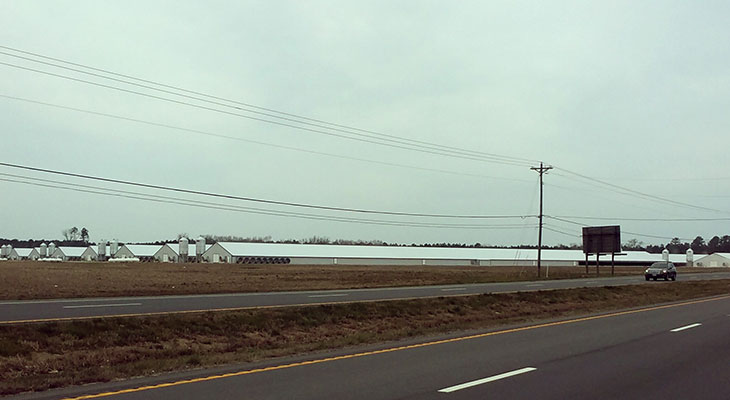
Multiple Poultry Houses at Large-Scale Poultry Farming Operation in Accomack County
Citizens for a Better Eastern Shore
The Clean Water Act of 1972: Regulating Animal Waste Discharges
The Clean Water Act establishes the basic structure for regulating the discharges of pollutants into the waters of the United States. The Clean Water Act began in 1948 as the Federal Water Pollution Control Act, which was one of the very first environmental regulations in the country. In 1972 the law was significantly expanded, and it became commonly known as the Clean Water Act of 1972, codified at 33 U.S.C. §§ 1251 to 1388. The Clean Water Act is overseen and enforced by the Environmental Protection Agency (EPA). The Clean Water Act at 33 U.S.C. §1370 allows a state to adopt its own water pollution control law, so long as the state program is no less stringent than the federal program. The Commonwealth of Virginia, like nearly all other states, availed itself of this opportunity by enacting the State Water Control Law, codified at Va. Code §§62.1-44.2 to 62.1-44.34:28.
The Clean Water Act made it unlawful to discharge any pollutant from a “point source” into navigable waters, unless a permit is first obtained. The permitting process is managed through a framework called the National Pollution Discharge Elimination System (NPDES). Any point source discharge not authorized by an approved NPDES permit, or an applicable statutory provision, is prohibited and can result in civil and criminal penalties for the polluter. Under the Act, a “point source” includes a Concentrated Animal Feeding Operation – or CAFO – from which pollutants are or may be discharged.
The original Act exempted most poultry operations because of the since-disproven belief that the dry-litter systems which most poultry operations use did not pose a significant environmental hazard. However, in 2003, the Act was substantially amended to explicitly include dry litter poultry operations. By way of explanation, the amended Act declares, “[d]ry poultry operations continue to contaminate surface water and groundwater because of rainfall coming in contact with dry manure and litter that is stacked in exposed areas; accidental spills such as from egg-wash facilities and drinking water lines; improper handling of large numbers of mortalities; and improper land application of litter.”[10]
What is a Concentrated Animal Feeding Operation (CAFO)?
The EPA uses a two-step, three-tiered definitional structure to determine whether a facility is a CAFO. The first step is to determine whether the operation qualifies as an Animal Feeding Operation (AFO). If an operation does not meet the definition of an AFO, it cannot be further classified as a CAFO and no NPDES permit is required.
What is an Animal Feeding Operation (AFO)?
An operation is an AFO if it is a facility on which animals are stabled or confined and fed or maintained for a total of 45 days or more in any 12-month period, and [c]rops, vegetation, forage growth, or post-harvest residues are not sustained in the normal growing season over any portion of the lot or facility. In other words, an AFO is a farming operation in which animals are kept and no crops are grown on the land.
If the operation in question meets the definition of an AFO, the second step is to determine whether it also qualifies as a CAFO. An AFO will be considered a CAFO if it falls into one of three categorical tiers.
Large CAFO
In the first category are “Large CAFOs,” as determined solely by the number of animals kept at the facility. For example, in the poultry industry an AFO would be defined as a large CAFO if it holds at least 125,000 broiler chickens or 82,000 laying hens.
Medium CAFO
The second category is a “Medium CAFO,” which includes facilities holding between 37,500 and 124,999 broiler chickens, or 25,000 to 81,999 laying hens. In addition, the number of animals, in order for a facility to be designated as a Medium CAFO, must also be designed to discharge waste into the waters of the United States, either through a manmade system or directly into the water. By this definition, an AFO holding over 120,000 chickens will not be regulated as a CAFO, and thus will not require an NPDES permit, unless the facility is intentionally designed to discharge waste into the waterways.
Small CAFO
Finally, a poultry AFO with fewer than 37,500 broiler chicken or 25,000 laying hens will be categorized as a “Small CAFO” on a case-by-case basis, if the permitting authority determines that the operation is a “significant contributor of pollutants to waters of the United States.” Unfortunately, the EPA and state regulatory authorities have been reluctant to categorize smaller chicken operations as CAFOs, even though they clearly have the statutory authority to do so under the Clean Water Act.
Attempts to Strengthen The Clean Water Act
Over the years there have been several attempts to strengthen the Clean Water Act, but most have met with limited success. Most notably, in 2003 the EPA began requiring all CAFOs to apply for NPDES permits, except in very limited situations in which the facility could make an affirmative demonstration that it had “no potential” to discharge waste into the environment.
This was a significant change from the way in which the EPA had previously enforced the Act, which allowed Medium and Small CAFOs to escape the permitting process unless their systems were intentionally designed to discharge waste into the waterways, and/or the facility was found to be a significant contributor of pollutants.
However, this new interpretation of the Clean Water Act was struck down two years later in federal court, when the Second Circuit found that the EPA had overstepped its statutory authority.[11] Since then the EPA has made several other attempts to require NPDES permits from facilities that “propose to discharge” pollutants, but so far all of these attempts have been invalidated by various federal courts.
Regulation of AFOs and CAFOs in Virginia
Although the EPA has the overall authority to administer the Clean Water Act through the NPDES permit system, most NPDES permit activities are actually carried out by the states. As a result, regulation of CAFOs and AFOs involves a complex system of federal, state, and local laws and administrative agencies which vary widely from state to state.
Many states use their own criteria to define what constitutes a CAFO, causing inconsistency in the scope of waste management requirements -- if such requirements even exist. A 2003 report issued by the U.S. General Accounting Office confirmed the inconsistencies, finding that many state-issued permits did not meet the EPA requirements. Furthermore, the report determined that several states had not issued any type of permits to CAFOs at all, leaving these facilities and their wastes essentially unregulated.[12]
In Virginia, the regulation of animal waste is administered by the Department of Environmental Quality (DEQ), and is regulated under both the Virginia Pollution Abatement (VPA) Permit Regulation (9VAC25-32) and the Virginia Pollutant Discharge Elimination System (VPDES) Permit Regulation (9VAC25-31).[13]
All poultry operations that hold more than 20,000 chickens must apply for a VPA general permit. Operations that are further classified as CAFOs must also obtain a more stringent Individual permit known as a VPDES, which is modeled after the federal NPDES permit. In addition to acquiring the VPDES permit, CAFOs must implement a site specific nutrient management plan developed by a Department of Conservation and Recreation (DCR) certified nutrient management planner and approved by the DCR.
A VPA general permit is easier to obtain than a VPDES Individual permit, and not as strictly enforced. For example, a VPDES permit has provisions for citizen enforcement, for managing dead animals, and for monitoring discharges from water lines and animal waste treatment and storage structures. It also requires an annual report to DEQ. By comparison, a VPA permit requires the monitoring of animal waste and does not require an annual report.
Farming operations that hold less than 20,000 chickens are considered “Small AFOs,” and require neither a VPA nor a VPDES permit. Instead, these operations are regulated by the Small Animal Feeding Operations Evaluation and Assessment Strategy, which is managed by DEQ in conjunction with the Virginia Department of Agriculture and Consumer Services (VDACS).
Under this program, the farming operations are evaluated for site-specific impacts to water quality. However, it is the DEQ’s stated intent to be “flexible” when making these site-specific evaluations of small AFOs. As a result, many poultry operations go unregulated in the Commonwealth.
Virginia’s Record on AFO Management
Despite the fact that the Clean Water Act was amended in 2003, to explicitly allow the regulation of poultry operations, the Virginia DEQ has been slow to issue VPDES permits. According to the DEQ’s list of current individual VPDE Permits which is available here, both Tyson and Perdue now have VPDES permits. However, as recently 2014, this was not the case. In 2014 the EIP, acting in conjunction with several other groups including the Assateague Coastal Trust, Virginia Eastern Shorekeeper, Potomac Riverkeeper, Shenandoah Riverkeeper and Waterkeepers Chesapeake, filed a petition with the EPA asking the Agency to enforce the state's Clean Water Act permitting program on the Eastern Shore and in the Shenandoah Valley.[14]
The environmental groups filed the petition because at that time, even though the state had over 1,000 AFOs, it had yet to issue a single VPDES permit. Speaking in 2014, DEQ spokesman Bill Hayden maintained that the reluctance to issue VPDES permits to AFOs was based on the DEQ’s interpretation of the Clean Water Act’s definition of a CAFO. Under that interpretation, the key distinction between an AFO and a CAFO was not the number of animals on site, but only whether the facility was designed to discharge waste.
Therefore, no matter how many hundreds of thousands of chickens resided at any one location, Virginia refused to issue a VPDES permit unless the facility was intentionally discharging waste. Explaining this reasoning, Hayden said, “Other people may look at [the definition of CAFO] differently," [but] the way we're looking at it, there is no CAFO operation if there's no discharge under Virginia's regulations."[15]
The reluctance to enforce environmental laws against large-scale farming operations may be due in part to political pressure exerted by the multi-million dollar poultry industry. As one Eastern Shore resident who wishes to remain anonymous put it, “Regulating the poultry industry on the Eastern Shore is like going against coal in West Virginia. Everyone knows that the industry is bad for the environment, but it’s one of the only industries we have here.”
This sentiment is echoed by some lawmakers in both Virginia and Maryland. For example, Maryland State Delegate Shane Robinson, speaking in 2014 on the need to enact tougher environmental regulations, said, “The poultry industry’s pollution has been a major problem in the Chesapeake Bay that Maryland has refused to confront for decades because of the industry’s political influence . . . and we need to follow through with these regulations, for the good of the Bay and everyone who loves and relies on the nation’s largest estuary.”[16]
It is not clear what caused the DEQ to finally begin issuing VPDES permits for large poultry operations, but it seems likely that an increased public awareness brought about by environmentally-friendly lawmakers such as Delegate Robinson and the efforts of groups like the EIP have been a driving factor in causing the change.
As was mentioned previously in this article, with respect to permits issued under the Virginia Groundwater Management Act of 1992, there is opportunity for the public to participate in the regulatory process that precedes the issuance of these VPDES and there is further an opportunity to challenge the terms of these VPDES permits in court. The public has an opportunity to participate when these VPDES permits are issued and also at the time when the VPDES permits are renewed.
The Citizen’s Environmental Lawsuit:
A Powerful Tool to Force Compliance When Regulators Decline to Act
The Clean Water Act, at 33 U.S.C. §1365, has a citizen suit provision that can be used to force an alleged environmental violator to comply with the requirements of the Clean Water Act and/or the State Water Control Act. Please refer to the Pender & Coward website for Jim Lang’s article describing the function and operation of citizen’s environmental lawsuits.
Our firm used the citizen suit provision of the Clean Water Act to force a polluter to clean up a waterway, after U.S. EPA and Virginia DEQ declined to act. There is a two-part series of articles on the Pender & Coward website that describe how this was done. Click here for part one and click here for part two.
The Need for Balance and the Power of Local Action
The negative impacts to the environment notwithstanding, the poultry industry is and will continue to remain vital to the economy of the Eastern Shore. The industry sends more than half a billion broilers to market every year, generating millions of dollars in revenue that is critical to the residents of Accomack County.
Given the importance of the industry to the Eastern Shore and the considerable political influence that it wields, any sustainable solution to the pollution problem can only succeed if it balances the legitimate needs of the industry with the right of the people to be free of pollution and disease.
Tougher Environmental Regulations
Tougher environmental regulations are one way in which balance may be achieved. There is little doubt that stronger environmental protection would have some negative impact on the poultry industry, just as the failure to adopt stronger environmental protection causes economic harm in terms of reduced property value, illness, and reduced tourism (to name a few).
For these reasons, the benefits of stronger environmental protection would probably be worth it in the long run. According to a November 2014 economic analysis conducted by Salisbury University, the value of improved water quality that would be created by enhanced phosphorus management regulations would be about $100 million, compared to a cost of implementation of $22 million.
However, especially in the current era of reduced environmental regulation under the current Presidential administration, any real progress is more likely to be made at the grassroots level rather than in Richmond or Washington, D.C. The ways for this to come about include citizen participation in the issuance and/or renewal of permits issued under the Groundwater Management Act of 1992, participation in the issuance and/or renewal of VPDES permits, court challenge if these permits are lenient in ways that contravene the governing statutes, and grassroots public pressure.
Citizens for a Better Eastern Shore
Local citizens groups made up of residents who live and work in the affected areas can be powerful voices for change. One such group is the Citizens for a Better Eastern Shore, or CBES. CBES is a non-profit group that is dedicated to promoting balanced growth while enhancing the quality of life and preserving cultural and natural resources for all Eastern Shore citizens. CBES works to accomplish this through education and by promoting open government and active citizen engagement.
The group has over 1,400 members primarily made up of residents from the Eastern Shore, but it welcomes anyone who is concerned about the environment, culture, and heritage of this truly unique part of Virginia. Membership information is available on the group’s website.
Donna Bozza, CBES’ Executive Director, captured the heart of the issue when she said, "We want to recognize that managing the Shore's poultry industry in a truly sustainable manner is difficult and complex," adding that CBES recognizes the importance of the industry to local farmers and the region's economy. "However, these important constituencies must be balanced against the fundamental right of our community to have clean water and clean air, to enjoy the benefits of living in this incredible place we call home." [17]
The power of an engaged citizenry should not be underestimated. Increased public awareness led by groups such as EIP and CBES have already had positive results. Tyson’s decision to discontinue tapping water from the limited resources of the Yorktown-Eastover aquifer is one example. The DEQ’s long-overdue decision to issue VPDES permits for poultry CAFOs is another.
In some cases, legal representation by a team of experienced environmental lawyers can help to achieve even more positive results. If you are concerned about the issue of groundwater contamination on the Eastern shore, or any other waterfront-related environmental issue, contact our firm and let us see if we can help.
[1] U.S. Gov’t Accountability Office, GAO-08-944,Concentrated Animal Feeding Operations: EPA Needs more Information and a Clearly Defined Strategy to Protect Air and Water Quality from Pollutants of Concern (2008), available at http://www.gao.gov/new.items/d08944.pdf [hereinafter GAO-08-944]
[2] Id.
[3] Id.
[4] Casey W. Ritz & William C. Merka, Univ. of Georgia Extension: Maximizing Poultry Manure Use Through Nutrient Management Planning 2 (2013), available at https://secure.caes.uga.edu/extension/publications/files/pdf/B%201245_3.PDF
[5] Id.
[6] Environmental Integrity Project, New Report: Manure Overload on Maryland’s Eastern Shore (December 10, 2014) available at: http://www.environmentalintegrity.org/news/new-report-manure-overload-on-marylands-eastern-shore/
[7] Id.
[8] GAO Report at 6.
[9] 9 VAC 25-600-20(B).
[10] Hannah Conner, Vermont Journal of Environmental Law, Vol 12, Comprehensive Regulatory review: Concentrated Animal Feeding Operations from 1972 to the Present (2010-2011). Available at: http://vjel.vermontlaw.edu/files/2013/06/Comprehensive-Regulatory-Review-Concentrated-Animal-Feeding-Operations-Under-the-Clean-Water-Act-from-1972-to-the-Present.pdf (hereinafter EIP New Report)
[11] Waterkeeper Alliance, Inc. v. EPA, 399 F.3d 486 (2d Cir. 2005)
[12] U.S. General Accounting Office, Livestock Agriculture: Increased EPA Oversight Will Improve Environmental Program for Concentrated Animal Feeding Operations, January 2003, GAO-03-285, p. 7.
[13] Virginia Department of Environmental Quality, Livestock and Poultry, Accessed at: https://www.deq.virginia.gov/Programs/Water/LandApplicationBeneficialReuse/LivestockPoultry.aspx
[14] Tamara Dietrich, Daily Press, Environmental Groups Petition EPA over Virginia Factory Farm Permit Program, October 13, 2014, Accessed at: https://www.dailypress.com/news/science/dp-nws-factory-farm-permits-20141013-story.html
[15] EIP New Report
[16] Id.
[17] Carol Delmarva, 13 News Now, Tyson Foods Taps New Eastern Shore Water Source After Growing Criticism. February 23, 2018, Accessed at: https://www.13newsnow.com/article/news/local/virginia/eastern-shore/tyson-foods-taps-new-eastern-shore-water-source-after-growing-criticism/291-522480246
